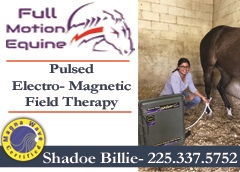My brother won Midnight at the Washington County Fair in 1962. The 2-y-o jet black Quarter Horse filly had originally been purchased at a Texas horse auction to be the centerpiece of a local Arkansas riding club fundraiser. As the new kids in town—and in the riding club—Glennie and I had felt overwhelmed by the assignment of selling ten raffle tickets each—and ended up buying most of them ourselves—but when the winning ticket was drawn things suddenly looked rosier.
As we waited for the arrival of a borrowed trailer that night, and as I soothed the skittish filly at the end of a lead rope with my sing-song rendition of “Red Sails in the Sunset,” I observed that she had a shape more like a Thoroughbred than a Quarter Horse—lean, lanky, and with a vestigial butt. Later, when we saw her registration papers we discovered she was also hopelessly inbred. (This was back when mating Quarter Horses to their daughters was a common practice and, as in this case, a choice sometimes even repeated in successive generations. Midnight was by Chief Stinson and out of a Chief Stinson daughter; Chief Stinson was by Chief P-5 and out of a Chief daughter. I couldn’t have made this up.) Still, we were ecstatic to welcome her to join our roan fox trotter gelding, Ginger Blue, at the barn.
You could probably say Midnight enjoyed a good life—despite being (as a result of inattention at the fairgrounds) “accidentally” in foal when we got her, despite nearly starving that first winter (as we reduced her food intake when the undiagnosed pregnancy made her appear increasingly big-bellied), despite displaying erratic moods under saddle (which we ascribed to the “scrambled brains” resulting from inbreeding), despite nearly cutting her leg off (while away during an unsuccessful attempt to get her pregnant again), and despite eventually having to be put down when she tested Coggins-positive in 1978. All in all, she got many years of sincere (if sometimes ignorant) care before she died—a fate enviable enough that I suspect many equines would welcome it.
When we euthanized Midnight, the Coggins Test was in its first decade of use. My dad, responsible as he was, had listened when the local veterinarian advised having all members of our herd tested. “But,” we thought when the results came back, “if Midnight hasn’t infected the rest of them in all these years, what’s the problem?” By then, however, the result was official and the choices inescapable—either we quarantine the mare, sell her for slaughter, or euthanize her. In Midnight’s case, a trip to the slaughterhouse appeared to make economic sense, but my dad couldn’t bring himself to consign her to the terrors of a cramped transport by cattle truck and the barely-humane slaughtering methods of the time, so we buried her in her pasture.
Dr. Leroy Coggins of Cornell University invented the agar gel immunodiffusion or AGID test—based on detection of antibodies to the EIA virus—in 1972 in order to counteract the scourge of Equine Infectious Anemia (then known as Swamp Fever), a sometimes fatal viral infection for which there was no known cure. Transmission occurs from exchange of blood between an infected and an uninfected equid, most often by bloodsucking insects, but sometimes as a result of unsafe veterinary practices such as reuse of hypodermic needles. Horses with virulent swamp fever in the 1970s died horrible deaths. Today the disease remains incurable, but insistent testing over time has reduced the incidence of acute cases to near-zero, so that now a horse declared Coggins-positive is almost always an asymptomatic “inapparent carrier,” as Midnight was in 1978.
It seemed unfair that we had to put down Midnight (or to quarantine her in conditions impossible to maintain) when it appeared she’d been an “inapparent carrier” even back before we got her; and she had, after all, spent more than a decade with pasture mates that tested negative (including even the buckskin colt she’d produced in the spring of 1963). I reasoned that, if Coggins testing merely detects the presence of antibodies to the virus, then how did we know Midnight hadn’t simply developed immunity to the disease? That is, how did we know we should euthanize her rather than congratulate her for successfully fighting off the disease?
Later I learned that the so-called “inapparent carriers” are indeed potentially infectious—they can be induced by stress to show symptoms and to increase exponentially in their viral load of contagious antigens. With a better understanding of the science, I’m no longer one of those sentimental horse owners reluctant to admit there’s a greater good done for others by a Coggins Test unfairly performed on my unlucky horse. After all, the failure of Midnight to transmit the disease to her pasture mates is merely anecdotal evidence of the relative unlikeliness of transmission as a result of her low viral load.
In the forty years since we euthanized Midnight I’ve gone along quietly with the bureaucratic requirements for annual Coggins testing of horses that show or travel. I did occasionally wonder though why I never again encountered a Coggins-positive horse. Recently I got curious enough to Google the subject—and learned that there is ongoing debate about the necessity for continuing the testing practice in its current (and rather expensive) form.
In the 70’s, when the test was introduced, it was not uncommon to see 10,000 positives annually. The number has decreased markedly in the intervening years—evidently a tribute to the success of the test. In 2010, for example, there were only 47 positives from 1.68 million tests. If each test costs $25-$30, then the annual expenditure for this test is over $50 million. In fact, the requirement for annual testing involves the collective expenditure by horse owners of between $.5 million and $1.5 million (depending on the region of the US) to identify each EIA-positive horse. It’s hardly a surprise that the most vocal Coggins naysayer Don Blazer points to the large pot of money as a compelling reason for veterinarians to continue the requirement for annual testing.
More measured critics, such as University of Kentucky veterinary researcher Dr. Charles Issel, have argued that, while the test may not have outlived its usefulness, the high economic consequence and low risk factor involved in current testing suggest that we need to rethink the details of the practice. In particular, the annual testing of horses that have been previously declared EIA-negative involves a huge waste of money. Of the approximately 2,000,000 samples tested for EIA annually, the number of horses testing positive after a previous negative result is virtually zero—ergo these are not the horses that need to be tested. Continuing risk of EIA infection derives instead from pockets of untested horses, usually in areas of the south and west where routine testing has been unpopular or ignored. As Dr. Issel puts it, “…testing the same negative horses each year does not protect our horses against EIA, does not effectively address the untested reservoir of EIA, and is greatly in excess of the risk.” Statistically speaking, retesting of previously-negative horses would be every bit as effective when required no more often than every third year.
In recent years the only statistically significant numbers of positive Coggins tests have resulted from requirements to test horses that are changing ownership. We can conclude that one effective way to find new cases of EIA is to require a Coggins Test at any change of ownership. Current state laws vary. While some states already have such a requirement, more than half do not, and there is no federal requirement whatever for proof of negative Coggins.
We have the tools to eradicate EIA completely (by mandatory testing of every equid, followed by segregation of the positives and retesting 60 days later of all equids that had been exposed to the positives), but in this era of libertarian suspicion of governmental overreach we are unlikely to institute such a universal mandate. Still, such measures have worked locally to render stables and even whole regions free of infection. Lesser measures, such as requiring Coggins Tests at all transfers of ownership and reducing routine re-testing requirements from every 12 months to every 36 months, would at least ensure greater safety at considerably less expense. After a decade of collecting undeniable data, it’s high time we considered these changes in our methods for dealing with EIA.
A note: A variant on the mandated quarantine of EIA-positive horses is permitted in Florida at the Friend’s Ranch, where EIA-positive horses are used on the quarantine site for recreation and for limited in-house competitions. After all, a 200-yard segregation from EIA-negative animals is considered sufficient to prevent infection by blood-sucking insects. So a third reasonable recommendation, also supported by Dr. Issel, might be to establish similar quarantine farms more widely for the retirement of inapparent carriers. In retrospect I wish we’d had that option for Midnight.
For more information on Dr. Issel’s recommendations for changes in Coggins requirements, see links at http://www.uky.edu/Ag/VetScience/EIA/index.htm especially to the articles “Control of EIA Should Take New Directions” and “Researchers: The Stigma of EIA is Misplaced” (both originally published at TheHorse.com in 2007).





